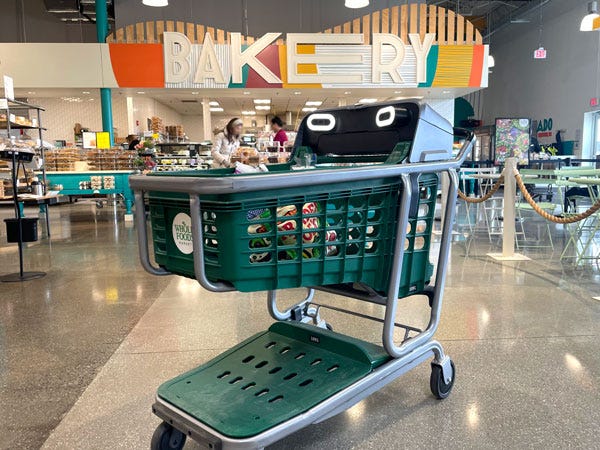Wednesday Walk: Spare Parts
Buying used stuff is hard, seeing myself on screen, the return of COVID
Welcome to Willoughby Hills!
As is typical every Wednesday, I’m bring you a smattering of topics that I hope will make you a bit more curious about the world around you and give you something to think about later. I call these Wednesday Walks, as it’s the type of conversation we might have walking down a path in the woods. Shall we take a stroll?
Second Hand Struggles
I’ve been trending towards buying more goods second hand lately, and speaking with Sandra Goldmark on the podcast last month has really solidified my commitment to buying used.
When I spoke to Goldmark, she discussed how consumers have an obligation to buy used goods. It’s not enough to simply donate our unwanted items to thrift stores or church rummage sales; there has to be a robust market for those used goods as well and those of us concerned with the health of this planet should be purchasing them.
One item that I’ve wanted for a while is a bike rack for my RV so that we can bring bikes with us on vacation and get around campsites and new cities. I’ve gone back and forth for a long time on which one might be the best fit and if that’s even a worthwhile purchase. A top of the line Thule bike rack can easily top $400.
This weekend, I happened to be browsing Craiglist and found a used Thule bike rack for $35. I couldn’t have emailed the seller fast enough! (And yes, I’m still on Craigslist. Despite using Instagram and sometimes Threads, I can’t bring myself to use Facebook’s main service, so I don’t use Marketplace.)
Even though it was an amazing bargain, I realized why people prefer new items. This particular rack is probably 10 years old or more. It’s in relatively good shape, but it also had some defects. For one thing, a few of the rubber straps on the cradles that hold the bikes in place had worn.
I tried to find an exact replacement through Thule, but couldn’t find the exact one. This led me to that strange murky world of searching for off-brand replacements on Amazon. I ended up ordering 8 new cradles and straps in a set for less than $25. They installed perfectly, although I overtightened the screw on one of them and it now wobbles in place.
I had the ethical dilemma of modern times. Amazon is pretty liberal with its return policy and I could easily have returned the broken cradle and repurchased a new set. But because the item was now considered defective and was of low value to begin with, Amazon most likely would have just trashed the cradles. And I can’t return one without returning all, can’t replace one without replacing them all. It’s just the way Amazon works.
I thought of the people in a factory overseas making these cradles, the ship that crossed the Pacific loaded with these cradles and tens of thousands of other widgets, all of the truckers and warehouse workers that moved these cradles around the country, and the driver who ultimately delivered it to me. The thought that all of that effort would get trashed because I overtightened a single screw seemed to hard to stomach.
The bike rack was also missing a way to attach it to my hitch when I bought it. I already had a hitch pin, so I figured this wouldn’t be a problem. But I learned that Thule uses a threaded bolt instead of a hitch pin. A replacement is about $16, or I can order a locking one that is more theft resistant for about $70.
I’m relatively handy and I have time on my side. I don't have a trip planned where we need to haul bikes with us, so I can take the time to seek out new parts and look at the best options. But I also recognize that I’m not the norm.
I’m lucky that Thule bike racks are both ubiquitous and fairly standard. It means parts are readily available, both directly from the manufacturer and through unlicensed bootlegs on Amazon. I can see why a more “regular” consumer would prefer to just buy something new and have it just work. I’m not sure how to solve for that in this case, but I thought it was worth noting my increasing shift towards second hand goods.
Being Watched
Earlier this year, I wrote about new shopping carts in my local Whole Foods Market which use built-in cameras to record purchases and allow customers to bypass the checkout lanes at the end of the shopping trip. At the time, these smart carts (known as “Dash Carts”) were the only option for self checkout, so they became my default way to shop.
I actually prefer using them because it spreads the checkout process out and feels more efficient as a result. So even when my local store finally added self checkout kiosks, I still found myself using the Dash Carts.
But when I popped into Whole Foods yesterday after work, the Dash Carts were roped off and seemed to be out of order. I hope it was just for a day or two and not a sign that this technology is going away.
At any rate, I only had a few items to pick up, so I decided to try the new self checkout lanes. As I started to scan my groceries though, I noticed something.
On the self checkout display was a video of my face, and it remained up the entire time I was scanning. I’m not surprised with the notion that there are cameras everywhere in a modern store, but there’s a big difference between suspecting you’re being recorded and being reminded that you’re being recorded.
I don’t recall seeing this in the past when I’ve used Whole Foods self checkout registers at other locations, nor can I remember seeing it at other places where I’ve used self checkout.
I wonder if this was done in response to a rise in retail theft. Dick’s Sporting Goods, for example, announced yesterday that theft is a factor in their lower than expected profit last quarter. According to CNN:
“The company blamed shrink, the industry term for theft and damaged inventory, for its surprisingly poor earnings. Although other national retailers have also warned investors about growing theft, Dick’s is among the first to blame its lackluster quarterly financial report primarily on theft.”
Theft seems to be a growing problem throughout the retail sector, though according to at least one Reddit post, most Whole Foods stores do not actively track down shoplifters and prosecute. Perhaps having a camera at self checkout is meant as a deterrent to stop people from ringing up organic bananas as the less expensive conventional bananas. At any rate, it was something new and noteworthy to me.
The Comeback Kid
It wouldn't be the start of a new school year in the post-2020 world without an uptick in COVID cases. In the case of Morris Brown College in Atlanta, mask mandates have been reinstated for the next two weeks to respond to a surge in positive cases.
I am encouraged to see school officials taking a stand that can protect the entire school community and I wish we would see more of that. I am not in favor of all people masking indefinitely (although I still opt to wear a mask in most indoor settings), but I think we should be flexible enough to adapt and bring back policies when the local case load warrants it.
To that end, I have been discouraged with how little discussion there is anymore about ventilation and filtration. This is worth pursuing in all buildings even without a deadly virus. The fact that it can mitigate risk from COVID seems to be icing on the cake.
In related news, Amy Goldstein wrote for the Washington Post this week about how a new study in Nature Medicine which looked at how long COVID symptoms may persist for two years or more after the initial infection:
“People who endured even mild cases of covid-19 are at heightened risk two years later for lung problems, fatigue, diabetes and certain other health problems typical of long covid, according to a new study that casts fresh light on the virus’s true toll.”
Goldstein goes on to quote from the study’s author:
“'A lot of people think, ‘I got covid, I got over it and I’m fine,’ and it’s a nothingburger for them. But that’s not everything,” said the study’s senior author, Ziyad Al-Aly, a clinical epidemiologist at Washington University School of Medicine in St. Louis. After a couple of years, “maybe you’ve forgotten about the SARS-CoV-2 infection … but covid did not forget about you. It’s still wreaking havoc in your body,” said Al-Aly, chief of research at the Veterans Affairs St. Louis Health Care System.
It’s a friendly reminder that COVID is still with us and may still pose a threat to people, both as a short term illness and with lingering, long term health effects. Stay safe folks!
I publish new issues every Wednesday and Sunday. Sign up to always receive the latest issue and support my work:
Other Wednesday Walks
If you’ve missed past issues of this newsletter, they are available to read here.










Buying / using a used item vs new almost always involves some trade-offs, primarily higher cost for convenience vs lower cost with imperfections. Can be tremendously rewarding to repair or jerry-rig something that's worn or needs replacement. Too many people can't assess these considerations and their additional time, skill & cost implications. However, there's tremendous value in sweat equity. I would call it priceless - the pride of DIY, learning something new, entering, exiting, shrinking, expanding your discomfort zone, shaping a before and after, at least giving something new a try are all essential life skills that are critical to growth, creativity, and problem solving.
Our Whole Foods self-checkout (we alternate between one in Navy Yard just south of Capitol Hill and in South Alexandria VA) stopped taking cash on Juneteenth. Go figure.
Also, Walmart has openly been prosecuting folks who don't ring up properly and have replaced most of their checkouts with self-check lanes.
And the CVS near our soon to be old apartment shut down and the one downstairs from our new one closes at 10 now. Sigh
Thanks for lifting up ventilation! I have all the masks in the world, but ventilation and HEPA filters and CO2 monitors are the next move if we actually want to clean the air and eradicate the virus in the air, along with better therapeutics and funding for said therapeutics. Masking is non-negotiable with our existing chronic illnesses, but we also have air purifiers and monitors and I would love for stores, hospitals, and public transit (including planes) to make this universal!